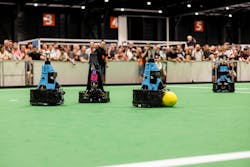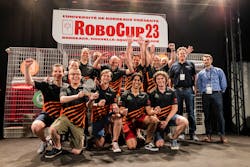EtherCAT soccer robots win RoboCup
Tech United is a multidisciplinary team with 46 members based at the Eindhoven University of Technology. United through their work in robot development, the team’s ranks include alumni, PhD candidates, faculty and staff with expertise in mechanical engineering, electrical engineering and advanced computer algorithms. The RoboCup stadium on the university campus is Tech United’s home base.
Tech United participates in tournaments around the world. RoboCup is an annual world championship for robots that can communicate and respond to an ever-changing environment. As an open-source competition, the teams share all of the knowledge gained after each tournament. The rules of the game also change every year to challenge teams to constantly improve and innovate with their technologies.
This is the sixth time that the Tech United team has won the RoboCup. They competed with their fifth-generation soccer robots—Tech United RoboCup Team: Limited Edition (TURTLE). The team implemented newly developed drives with swivel axles this year in place of omnidirectional wheels. This change enabled individual control of each wheel’s orientation. Enhanced traction significantly improved the acceleration of the robots. Tech United relies on EtherCAT for its communication technology, as they have done since they brought out their first generation in 2005.
The software for controlling the robots consists of four modules: vision, world model, strategy and motion. The vision module processes data from the vision sensors, such as omnivision images, to determine the positions of the ball, opponents and the robot itself. This position data is fed into the world model. Here, image data from all team members is combined to create a unified representation of the environment. The strategy module makes decisions based on this generated world model. Finally, the motion module translates the strategy module's instructions into low-level control commands for the robot's actuators.


